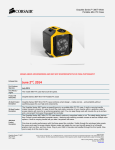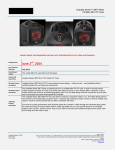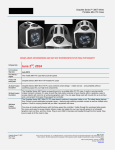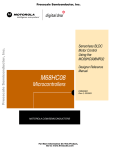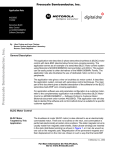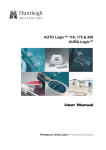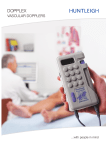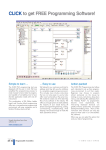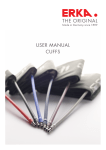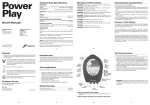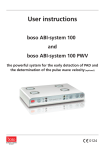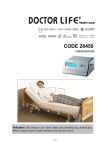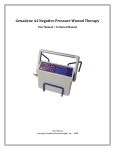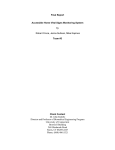Download FREQUENTLY ASKED QUESTIONS
Transcript
FREQUENTLY ASKED QUESTIONS The following table provides a FAQ guide for the Dopplex Ability Automatic Ankle Brachial Index System ® QUESTION Are larger cuffs available? What is suggested to use if there is an ulcer / wound present? How are the cuffs cleaned? ANSWER Not at present. However the standard cuffs are designed for arms of circumference 29-46cm and ankles of circumference 25-40cm. These cuffs will fit the majority of limbs and are larger than the standard ones used on NIBP systems. A suitable dressing should be applied to the wound and then Infection Control Barrier Sleeve (ICBS) provided should be placed over the leg prior to the cuff placement. Always use the ICBS on patients with any type of skin condition or on every patient to eliminate the need to clean the cuffs. They should be wiped down using a neutral detergent or soap powder at 40degC. Then wipe with 70% isopropyl alcohol wipe or a chlorine releasing agent at 1000ppm available chlorine. Rinse with clean water to remove residue and dry thoroughly. Always use the ICBS on every patient to eliminate the need to clean the cuffs. The Ability measures systolic pressures on all four limbs and then calculates the ABIs as follows: Left ABI = Left ankle pressure Highest Arm pressure How does the ability calculate the A B I s? How many infection control barrier sleeves (ICBS) are supplied with the main unit? Will this replace my Doppler? What are the guidelines on PAD? What does the waveform indicate? Right ABI = Right ankle pressure Highest Arm pressure This is the method recommended in all UK, European and Transatlantic guidelines. A box of 100 sleeves is supplied with each unit. Recorder code ACCVAS-016 No. The Ability can be used on most patients but some will require a more in depth assessment using Doppler and waveform analysis, or toe pressures and Pulse Volume Waveforms. The Ability unit should be used as the first line ABI assessment tool and will work on most patients. This ensures that the majority of patients can now have a rapid ABI and then patients with PAD or those that cannot be measured should have a Doppler ABI and waveforms recorded. Recently published guidelines from ESC (2011), TASC2 (2006) and ACCF/AHA (2011) all state that the first line assessment tool for patients suspected of PAD is the ABI, and the second line assessment is Doppler waveform recordings, toe pressures or Pulse Volume Recordings. The printout from Ability shows ABIs and PVR waveforms which are first and second line tests for PAD. The PVR waveform provides additional information about the pressure pulse at the ankle. This waveform will help in the case of calcified arteries or when an ABI > 1.4. An application note describing normal and abnormal waveforms is available (7711158-1). The PVR waveform is now recommended as the second line test for PAD, following an abnormal ABI or incompressible arteries. These recommendations are in the guidelines from TASCII (2006) and ESC (2011). Page 1 of 4 Issue 1 / VAS12 QUESTION What is the difference between the Ability and an oscillometric device? In my hospital, we calculate the ABI using the lowest pressures. Can this be done by the Ability? How does the Ability measure the highest systolic pressure? Surely this device is no good for diabetics as toe pressures are required? How long does the battery last from full charge? If the unit is used by clinical support staff, who becomes liable for the results? Why only 1 year warranty? What are the contra-indications for use? Can the system be used on patients with only one arm? ANSWER Ability uses an innovative dual chamber cuff to measure more reliably the systolic pressures in the ankles and is NOT based on oscillometric technology. It works on the basis of volume plethysmography and uses the distal chamber on each cuff to detect the changing volume of the limb to measure the systolic pressures. Oscillometric devices are based on NIBP technology and were developed for the arm measurements. They have not been able to produce good results on the ankles and therefore are not very reliable in measuring ABIs. It is not clear as to which vessel the systolic pressure is measured in. No. The Ability measures the highest systolic pressure of all three arteries in the ankle. If the lowest systolic pressure in the ankle is required, a Doppler or Vascular Assist should be used. The Ability ‘effectively’ measures the systolic pressures in all 3 limbs and reports the highest of the 3. It does this by inflating the occlusion chamber over systolic pressure and then deflating this chamber while measuring the volume change in the distal (sense) chamber. The point at which the volume in the sense chamber increases is the systolic pressure. The vessel with the highest systolic pressure will start to increase the volume in the foot first. The other vessels will then contribute when the occlusion chamber drops to their systolic pressure. This way, because of physiology, we measure the highest systolic pressure reading of all 3 vessels in the ankle. Not all diabetics have calcified arteries and the Ability can be used on these patients. The PVR waveform should also provide evidence of the presence of PAD when results are ‘normal’ or ‘incompressible’. It will allow 10-15 tests to be undertaken on a full charge. It must be recharged at least once a month otherwise the battery will not be recharged by the Ability (early models only; serial no 300-11 onwards). The clinician responsible for the patient is liable for the results and they should always review the Ability results together with the clinical signs, symptoms and history of the patient. Any ABI, whether with Ability or Doppler, should be part of a holistic approach to the assessment. This is a new product which always initially has a one year warranty. This will be extended as time progresses. The contra-indications for use are listed in the user manual & are: • Suspected or presence of a DVT • Cellulitis • Anybody under 18yrs of age • Management of pulmonary hypertension No. In this case a Doppler ABI should be undertaken. To maintain its simplicity of use, only patients with a lower limb amputation can be measured. Page 2 of 4 Issue 1 / VAS12 QUESTION ANSWER This is because some patients have very high or low pressures, very oedematous limbs or keep moving and cannot keep still. The patient MUST keep still and not talk, cough or laugh. The cuffs or tubing MUST NOT be touched during the test. Always explain the procedure to the patient and add that the cuffs will go tight on the arms and then the legs. Why does the unit not work on all patients? Why does the ABIlity produce a message ‘Cannot Measure’? What paper type is supplied with the unit? In the case of an error ‘cannot measure’, a retest is suggested or a Doppler arm exam is recommended. Often, the patient is more relaxed on the retest and a result is then produced. The ABIlity will not work on the following patient groups with: • Calcified arteries i.e. systolic ankle pressures above 205mmHg • Severe hypertension • Parkinson’s Disease • Mastectomy • Severe PAD with ankle pressures below 60mmHg • Lymphoedema • Any condition that prevents both arm pressures being measured • Very oedematous limbs The ABIlity uses very small pressure signals from the cuffs to calculate the systolic pressures. The following list should be adhered to and will improve the number of times a result is produced: • Mobile phones, Blackberry’s etc, must be at least one metre away from the unit • The patient must lie supine, be relaxed and remain perfectly still • The operator must not talk to the patient – this always prompts responses from the patient • The patient’s arms must be supported by the couch • The patient must not be pushed up against a wall • The arm cuffs should not be pulled in tightly against the body • the patient must have an explanation of what to expect i.e the arm and ankle cuffs will go tights and the total test will only take about 3 minutes • The operator must not touch the cuffs or knock the tubing during test • The cuffs must have the correct tension – a snug fit (taught but not tight) • The arm sense chamber must be located just below the elbow on the largest diameter part of the forearm. The connecting strap between the two chambers does not need to be flat. • Check that the clothing is not too thick. The cuffs can be applied over thin shirts and socks or tights • The patients heels must be supported on the couch and not overhanging the end • When performing repeat test on the same patient, allow at least 5 minutes for stabilisation between tests One roll of plain paper and one roll of adhesive backed label paper are supplied with the unit. Paper can be reordered in packs of 5 rolls using the following order codes: • Standard plain paper (pack of 5) ACC-VAS-017 (approx 55 printouts with waveforms/roll) • Adhesive backed label paper (pack of 5) ACC-VAS-019 (approx 35 printouts with waveforms/roll) Page 3 of 4 Issue 1 / VAS12 QUESTION Why should I register the unit with Huntleigh Why does my ability unit keep turning off? What are the maximum and minimum pressures that the ability can measure? What are the maximum pressures applied to the patient? What is the accuracy of the blood pressure measurement? Why do i need to purchase a fixing plate? How do I access the demo mode? What is the USB connector used for? REFERENCES ANSWER We add your name and email address to our database so that we can notify you when software upgrades are available. These can be undertaken through our website. Ensure that the battery is connected and is fully charged. On units with software version 192.2 and 213.2, the unit will switch off if the battery is completely discharged, even when the unit is connected to the mains supply. A software upgrade will be available, on our Sharefile website, to overcome this problem. Access passwords to sour Sharefile are available from our service department. When operating on battery, the LCD backlight will switch off, sometimes giving the appearance that the unit has turned off. To see the display again, press any button once. The Ability can measure arm systolic pressures in the range 80205mmHg and leg systolic pressures in the range 55-205mmHg. The maximum pressure applied to the arms and ankles is 230mmHg. However, if the patient has an ankle systolic pressure of less than 160mmHg then the maximum ankle pressure applied is 180mmHg. The accuracy of the blood pressure measurement has not been measured. Instead we have compared the ABI values from Ability with those of Doppler. This comparison is shown as a correlation and agreement, because Doppler has high variability in its results. These agreements are described in the clinical evidence brochure. A fixing plate is required to mount the Ability unit onto either the pole stand (trolley) or wall bracket. It is a separate accessory because it adds weight and cost to a unit and is not required if the Ability is only going to be used in the carry bag. From the boot screen, select setup (spanner icon) and scroll down to the service menu. Select service menu and enter the PIN code 5315. Now select demo mode and dummy results will be shown which is ideal for an exhibition where a volunteer is not available. The unit will now operate as normal and will require cuffs to be connected and placed around a manikin. Normal results (ABPI > 1) will be produced. The USB connector on the rear of the unit can be used for firmware upgrades and transferring data to a PC (when DR4 is available). Firmware upgrades are available from our Sharefile website and requires a password for access. This password is available from our service department. A standard USB to mini USB cable is required, and is supplied with later units and is also available from Huntleigh. The USB is electrically isolated, for safety reasons, and does not provide 5volts for operating memory sticks etc. TASCII (2006) ESC (2011) ACCF/AHA (2011) Page 4 of 4 Issue 1 / VAS12




